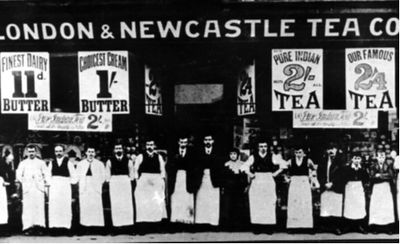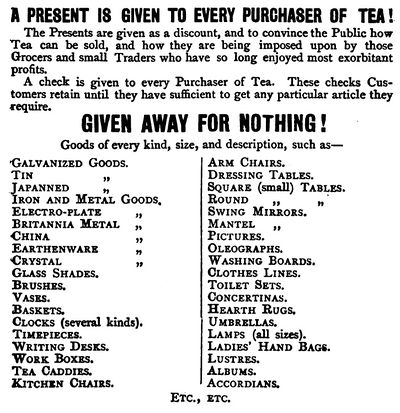London & Newcastle Tea Company
The London and Newcastle Tea Company was established by James Alfred Game in 1874 and grew to be one of the largest grocery companies in the UK. It had it's headquarters in Charlotte Square, Newcastle.
Expansion
The company initially operated through a network of grocery stores that sold the company's tea. The company was very successful, soon operatng it's own stores and becoming one of the first five grocery and provisions firms in Britain to operate in a multiple branch scale. In 1875 it was running between 10 and 20 branches. However by 1879, the company was claiming to be the largest tea company in the UK with almost 70 branches, making it the second largest grocery chain in Britain. The company opened some stores specialising in Drapery and millinery goods. In this year these companies were moved into a subsidiary, London and Newcastle Trading Company, which appears to have changed it's name to the London and Newcastle Supply Store. No checks appear to have been issued under the name of the London and Newcastle Trading Company or the London and Newcastle Supply Store.
In 1884 they advertised that they had 45 stores in Scotland, 25 stores in England, 21 stores in Ireland and 7 stores in Wales. The number of stores on named checks is:- 40 in Scotland, 18 in England, 20 in Ireland and 7 in Wales. The highest store number on the unnamed checks is 94. It was claiming to be the largest tea seller in the world.
Division and Contraction
By 1886 the company had reduced to 35 stores in Scotland with 85 branches in total. In 1888 it was claiming a total of 60 branches in Scotland and England only - the Irish stores were owned seperately by 1886, see below.
In January 1894 the London and Newcastle tea company was owned by Stevens, Pickering, and Co with it's subsiduary, London and Newcastle Tea Stores mainly owned by Pearse and Co. with one store, 66 West Grainger Street owned by Stevens, Pickering, and Co.[1] Both partnerships were operated by Henry Stevens, Thomas Pickering, John James Maguire and Walter Pearse. Henry Stevens left the partnership at this time, taking control of the subsiduary London and Newcastle Supply Stores. The three remaining partners changed their partnership name to Pickering and Co. and retained the London and Newcastle Tea Company stores. At this time the stores were as follows;
London and Newcastle Tea Company
Berwick-uppn-Tweed, Bishop Auckland, Consett, Darlington, Durham, Gateshead, Honghton-le-Spring, Jarrow, Monkwearmouth, Newcastle-upon-Tyne, North Shields, South Shields, Sunderland, Seaham Harbour, Spennymoor, Aberdeen, Alloa, Arbroatb, Ayr, Brechin, Coatbridge, Dalkeith, Dumbarton, Dundee, Dunfermline, Edinburgh, Falkirk, Forfar, Galashiels, Glasgow, Greenock, Hawiok, Kilmarnock, Kirkcaldy, Lochee (Dudee), Montrose, Paisley, Perth and Stirling
London and Newcastle Supply Stores
66 West Grainger Street Newcastle, York, Middlesborough, West Hartlepool and Glasgow
London and Newcastle Supply Stores head office was at West Grainger Street Newcastle. In 1903 it obtained Royal Warrants of Appointment for groceries, whic was not renewed hen Gearge V succeeded to the throne. By 1939 the London and Newcastle Tea Company was owned by Londan and Newcastle Stores Limited and by the early 1960s London and Newcastle Stores was part of Associated British Foods, which included the new Fine Fare Stores. Management of the London and Newcastle stores was transferred to Fine Fares, with the stores being closed as new Fine Fare stores opened. The last London and Newcastle store closed around 1964.
What a Checks was Worth
The checks were issued for the company's loyalty scheme, which it established in 1875 an advertised as a means of "selling only for Cost, and sharing Profits with our Customers". checks were given with each tea purchase, representing the amount of tea sold. Customers could collect checks until they had acquired enough to claim goods. In 1876 the smallest check available was for 1/4lb of tea. Goods available in June 1876 were;
Checks for 1lb Tea
A butter cooler, a tea caddie, a sugar bowl and cream jug, a china cup and saucer, a flower vase, a crystal plate or bowl.
Checks for 2lb Tea
A tea pot, a new design butter cooler, a large sugar bowl and cream jug, a pair of behemian vases, a china brakfast cup and saucer.
Checks for 4lb Tea
A metal lined teapot, a set of stone jugs, a handsome biscuit jar, a jet and gold sugar bowl and cream jug.
The goods available extended to included toys, crockery, other household items. The advert from 1884 includes furniture.
Scotland Checks
Starting off with the Wellgate, Dundee, the London and Newcastle Tea Company opened 7 Howard Street and 182 Gallowgate in June 1876. The Scottish operation soon grew to be the largest part of the company.
- Aberdeen
- Alloa
- Arbroath
- Ayr
- Brechin
- Coatbridge
- Dumbarton
- Dundee
- Dunfermline
- Edinburgh
- Falkirk
- Forfar
- Galashiels
- Glasgow
- Greenock
- Hawick
- Irvine
- Kilmarnock
- Kirkcaldy
- Leith
- Montrose
- Paisley
- Perth
- Saint Andrews
- Stirling
England Checks
- Bishop Auckland
- Byker
- Consett
- Crook
- Darlington
- Durham
- Gateshead
- Jarrow
- Newcastle
- North Shields
- South Shields
- Sunderland
Ireland Checks
In Ireland the original London and Newcastle company ceased trading in 1886. Adam Frisken Torrie,born in Chrinside Berwickshire in 1856, was employed by the London and Newcastle Tea Company in Newcastle and transferred to Ireland in 1874. He was in Cork by 1884 and Dublin by 1886. In 1886 Adam entered into partnership with Thomas Pickering and John Pickering to form T. Pickering and Co and take over the Irish operation of the London and Newcastle Tea Company. In April 1887 Thomas Pickering left the partnership with Adam Torrie and John Pickering continuing it. At this time they had stores in Bandon, Cork, Clonmel, Drogheda, Dublin, Galway, Kilkenny, Kingstown, Limerick, Waterford and Wexford[2].
Adam Torrie eventually took full control of the stores. When he died in November 1928 his sons Robert and William took over, forming the company Adam F Torrie Ltd in December 1929, and expanded the business, aquiring 20 new stores in Munster and Leinster. Eventually there were 18 supermarkets and Waterford alone boasted five stores, one a superstore. The last Waterford store closed in 1986 and the company was eventually bought in 1995 by Musgraves with the remaining stores rebranded SuperValu.
The later Irish checks carry a facsimile of Adam Torrie's signature. The signature on the 1890 checks is compared to Adam Torrie's signature on his 1901 census return opposite. The check signature is Adam F with a coarse repsentation of the beginning of his last name - Tor.
- Belfast
- Carlow
- Clonmel
- Cork
- Drogheda
- Dublin
- Galway
- Kilkenny
- Kingstown
- Limerick
- Londonderry
- Sligo
- Waterford


